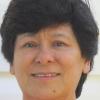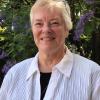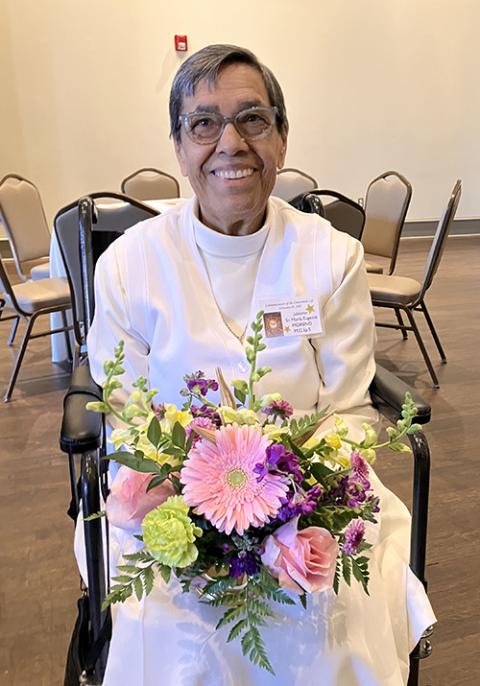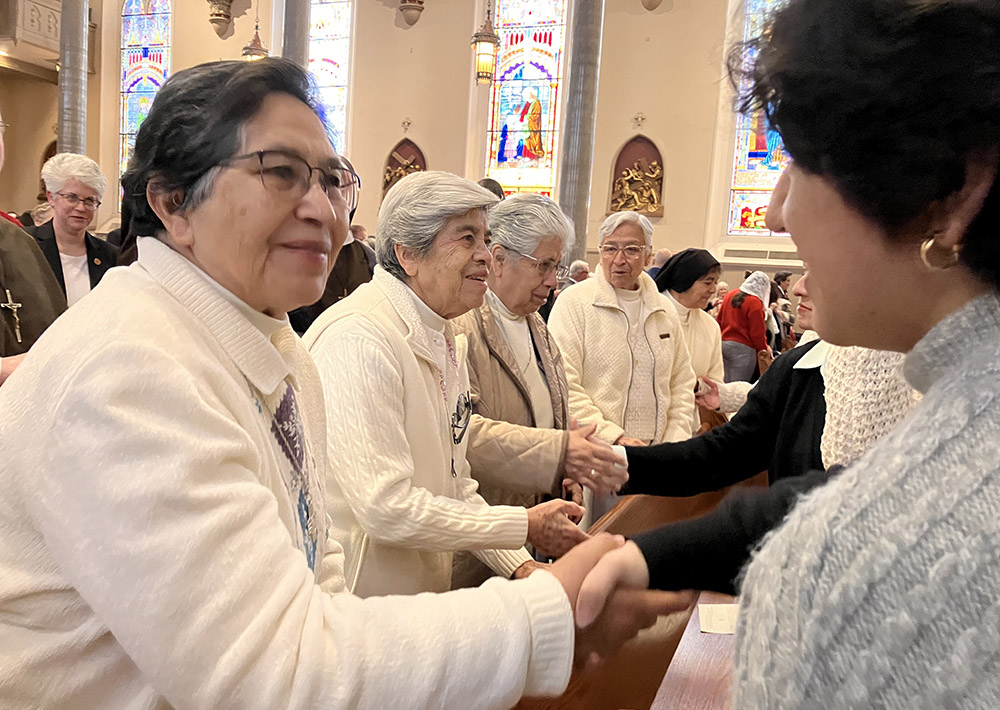
Sr. Rosa Cruz of the Guadalupan Missionaries of the Holy Spirit gives the sign of peace to Leslie Bocanegra, a young woman invited to attend the Mass to celebrate the World Day of Consecrated Life at St. Paul's Cathedral in Birmingham, Alabama. (Courtesy of Maria Elena Méndez Ochoa)
While taking a class on psychogerontology at St. Mary's University of Minnesota, I became concerned about the reality of religious communities in which the number of vocations is decreasing and the number of elderly religious is increasing, especially in the United States.
Suddenly, and almost without realizing it, we find ourselves at what Ted Dunn calls "graced crossroads." These crossroads ask us: What about sustaining your mission and caring for the soul of your community? Whether we like it or not, communities are being forced to change during this time of transition, but could there be a deeper invitation to transformation and new life?
It places us in an urgent situation, facing life-and-death decisions.

"Graced crossroads": Sr. Marta Lucía Tobón of the Guadalupan Missionaries of the Holy Spirit leads sisters in a group exercise. (Courtesy of Maria Elena Méndez Ochoa)
Looking at the reality of religious life, the Center for Applied Research in the Apostolate (CARA) at Georgetown University has reached the following conclusions: "Eight in ten responding religious institutes (82%) had no one professing perpetual vows in religious life in 2022. ... The average age of responding religious of the Profession Class of 2022 is 33. Half of the responding religious are age 34 or younger. The youngest is 25 and the oldest is 75."
Sometimes, in religious life, we feel discouragement, fear, and insecurity about the future and, at the same time, certainty and courage, knowing that at the end of the tunnel there is light. We know that after a dark night there will be dawn, and a bright sun will dispel a cloudy morning.
We all know that aging is inevitable, but how are we preparing ourselves? What changes are we making to remain productive?
I propose for our reflection three elderly women from the Bible who give confidence to religious life. Two of them opened themselves to the miracle of life by becoming mothers with "dry" wombs at an advanced age. The other lived her whole life waiting for the Messiah.
I speak of Sarah, Elizabeth and the prophetess Anna. These old women with barren "wombs" are signs of hope for religious life today, centuries later.
First, there is Sarai — Sarah as she is better known — who appears in the Old Testament. In Genesis 11:30 we find that Sarah was barren and childless. Later, she and Abram receive a promise from Yahweh with the condition that they leave their country to go to the land he was going to show them (Genesis 12:1-2).
Advertisement
Only if they were able to leave and go forth into the unknown could they see God's promise to them fulfilled, in spite of their advanced age. Emigrating from what was secure implied breaking their own patterns and structures in order to open themselves to something new. Only in that movement would the blessing be given. And Abram was 75 years old when he left Haran (Gen 12:2, 4).
In Genesis 18:1-15, Yahweh visited Abraham and Sarah in the form of three angels, who told them that Sarah would have a son when they visited the next year. Sarah did become pregnant, bearing Abraham a son in his old age, and they named him Isaac (Genesis 21:2-3).
Then there is Elizabeth, the mother of John the Baptist. As in the case of Sarah, Elizabeth — advanced in age and barren — miraculously became pregnant (Luke 1:24-25). Once the child was born and she became a mother, Elizabeth and the entire community celebrated God's blessing.
Finally, we find Anna, also "advanced in years" and childless. "She never left the temple, but worshiped night and day with fasting and prayer" (Luke 2:36-38).
Anna was in the Temple when Joseph and Mary brought Jesus there, and Anna was granted the grace of meeting him. Following that encounter, Anna "gave thanks to God and spoke about the child to all who were awaiting the redemption of Jerusalem" (Luke 2:38), and so became a prophetess in her community.
Seeing how faith, hope, and fruitfulness have been active in elderly women with barren wombs, like Sarah, Elizabeth and Anna, we believe that God can internally make our communities fruitful.
Religious life, like the lives of these women, seeks to give life to the call and charism that God has entrusted to it, so that we may continue to respond to the world crisis in a prophetic way, even in its fragility.
Pope Francis has reminded us, "In the Bible, longevity is a blessing. ... Life is a gift, and when it is long it is a privilege."
In speaking of old age, the Pontifical Academy for Life later affirmed the thoughts of Francis: "Being elderly is a gift from God ... to be safeguarded with care. ... The pandemic [COVID-19] has given strength to our awareness that the 'wealth of years' is a treasure to be valued and protected."
Anselm Grün, in his book The Art of Aging, tells us that "everyone must find for themselves the path that will lead them to age well and to master the art of growing old," because, sooner or later, we are going to live it personally, or we are already living it in our communities.
If growing old is an art, it is also an opportunity to rediscover, in the words of a commentary on Revista Vida Religiosa, the " 'verbs of transformation' that are beginning to acquire an unsuspected vitality: to learn, to listen, to initiate, to innovate, to inaugurate. ... It is as if the Spirit were insisting that this time has no need to only remember; it needs action, reality, unparalleled commitment, and newness. And this is where, curiously, the consecrated life of this era is well prepared for prophecy."
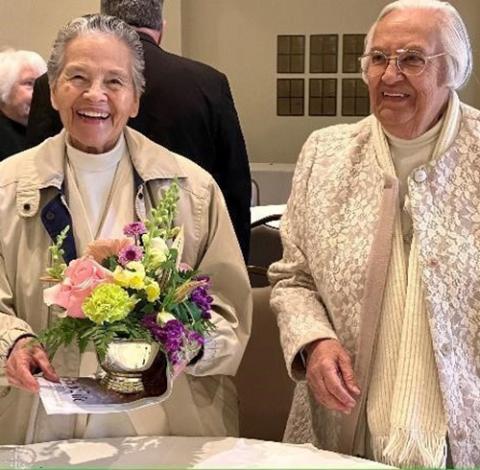
Srs. Edith Lugo and Teresa Aguiñaga, both Guadalupan Missionaries of the Holy Spirit, enjoy the reception for Sr. Maria Eugenia Moreno's 50th jubilee of religious life in Birmingham, Alabama. (Courtesy of Maria Elena Méndez Ochoa)
This stage of maturity is the opportunity to deepen and integrate what is most valuable in the depth of "being" a human person, and to discover the beauty of who God has made to be as persons.
At this stage, activism, haste and great worries come to an end. It is the time for intimacy — relationships with sisters, friends, God, and oneself — which keeps us from isolation, sadness, depression and/or exclusion. Old age is like the autumn of our life because it is a time to reap the fruits of the harvest that we have sown in life.
Grün suggests that "just as the sun withdraws its rays to illuminate itself, the elderly person should turn inward, withdraw into his or her own being, and discover the richness of his or her inner self. It is a time of gratitude, forgiveness and reconciliation with oneself, others, and the world, and thus, to turn one's eyes towards 'wholeness.' "
Old age is a time of blessing that can be used to leave traces of hope for future generations, to tell stories, and to write experiences that will nourish the lives of others. It is true that there are few vocations to religious life, but that does not mean that it is dead; it is simply being transformed.
Dunn assures us in Graced Crossroads:
The good news is that religious life is not dying. It is transforming just as it has through many lifecycle changes since the time of Jesus. It is on the leading edge of an evolving consciousness in support of our planetary evolution. ... The good news is that you are a part of this Great Turning. ... Religious life will rise again, but there are hard choices ahead, and there are no quick fixes, simple or off-the-shelf solutions. ... The only solace, perhaps, is that God is with you and will not abandon you. This is God's covenant (Deuteronomy 31:6).
Old age is time to move out of the spotlight and allow God to continue to make our "wombs" fruitful, as he did with Sarah, Elizabeth and the prophetess Anna.
